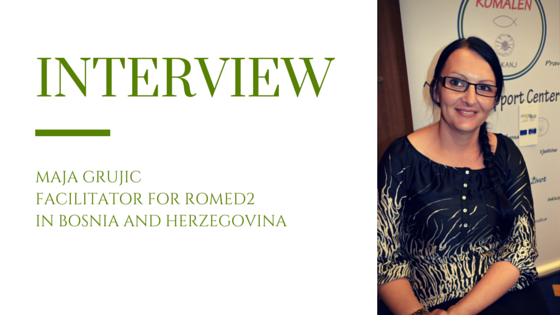Interview with Maja Grujic, Facilitator for ROMED2 in Bosnia and Herzegovina
Maja Grujić works for World Vision in Bosnia and Herzegovina, an organization that supports the ROMED2 Programme in Bosnia and Herzegovina since its beginning in 2003. She has been on the of facilitators implementing the ROMED2 methodology in several municipalities in Bosnia and Herzegovina. The last ten years or her professional life has been focused on Roma- related programs.
What was biggest challenge within the ROMED2 Programme?
For me, the biggest challenge from the beginning was the process of bringing together stakeholders that were at that time on totally opposite sides: the Roma community and Roma representatives and representatives of the local institutions. The challenge was to bring those two sides together and to develop some kind of cooperation and communication and eventually, even a regular and daily cooperation as well as developing a joint agenda and common goals focused on Roma population.
There had been several attempts of representatives of the local authorities and Roma organizations to work together before but they were rarely meeting, joining forces and planning together to reach some common goals.
What do you consider to be the biggest challenge for you as a facilitator?
For me, this lack of cooperation was challenging as I had to work with both sides: the Roma community and the local authorities. It was hard for me to find the balance between the two of them. They perceived each other as enemies! Before ROMED2, a Roma would want to do something, and the authorities would want to do something else, completely opposite or in a totally different way... The ROMED2 Programme and everything we did within it: the visits, the trainings and all that work, helped us to enhance cooperation and some kind of “peace” between those two sides. Now they are working and planning together and that is for me, personally, the biggest result that we could achieve.
What are the most significant changes that you witnessed since the beginning of the ROMED2 Programme?
There are many. I would like to mention the Roma Mediators first. You must have in mind that they were mostly young activists from organizations, or simple citizen from Roma communities. Improvement of their work in the last two years is visible. They gained an understanding that they are an equal part of our society and that they can be leaders for positive changes. There is also a significant improvement in the communication between institutions, Roma organizations and the Roma population. During our meetings on local level, we have representatives of the Centre for social work, schools, police, government and the Roma population. Before ROMED2, such cooperation was unthinkable!
Representatives of the local authorities now recognize Roma representatives and mediators as valuable human resources and partners in their work, calling and contacting them, asking them to be the link between the Roma population and them.
What are the main needs defined by the Community Action Group in the municipalities you are in charge of?
When we started working with Community Action Groups, it was very hard to identify one or two most important problems, since there was so much to be done. Those problems where always focused on employment, health, and emigration of the Roma population. Every community tried to identify one or two issues that could be solved and that could be targeted with some initiatives. For example in Visoko, the initiatives of the CAG were related to the emigration issue. It developed a model of support for Roma parents informing them about what they need to know and what they need to do to increase chances for their children to continue school once they return from abroad.
How did the Joint Planning meeting go between the CAG and the local authorities? What are the developments since the first of such meetings?
There was definitely a significant and surprising progress! Before ROMED, representatives of the local authorities and Roma representatives didn’t even perceive some particular issues the same way. Today, they do not only see things the same way, but they also search solutions and raise initiatives together.
Do women participate in the communities where you are a facilitator? How about young persons? If no, why not?
Actually, what is surprising with the ROMED2 Programme is that our mediators are young men and women, and that they equally participate in this program. We do hope that those young Roma men and women will continue these good practices and examples for the benefit of the Roma population.
If you had to name three values you have retained personally from the process, what would those be and why?
Personally I gained faith that we can do something to improve the life of the Roma population in Bosnia and Herzegovina! I can say that this program made me personally a richer person: I met so many wonderful and dedicated people; I am inspired to continue my own work. This programme inspired me in many other ways for my work on Roma-related issues.
Where do you see the future of this program?
For me, the future of this program is in the employment of Roma within the institutions. If one day I have to take my child to the doctor, I would like to see a Roma doctor there, Roma professionals in the Centre for social work, in schools… I can see that this program will lead to the situation that Roma mediators are equally treated in the society that we are living in.

